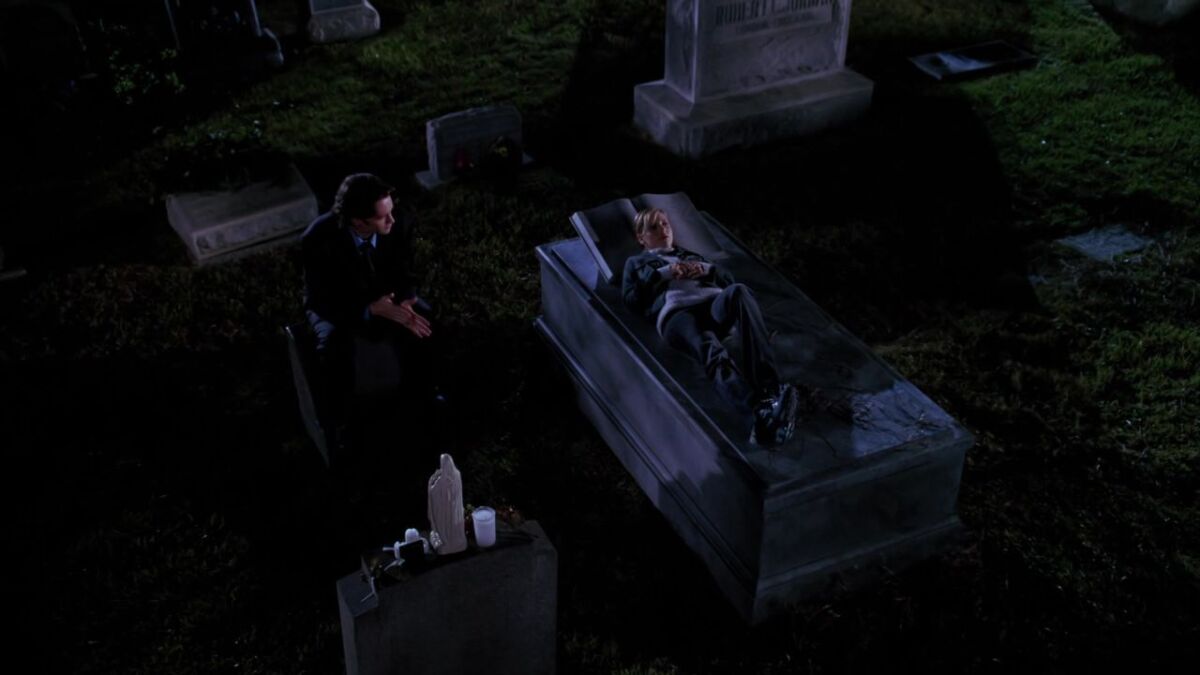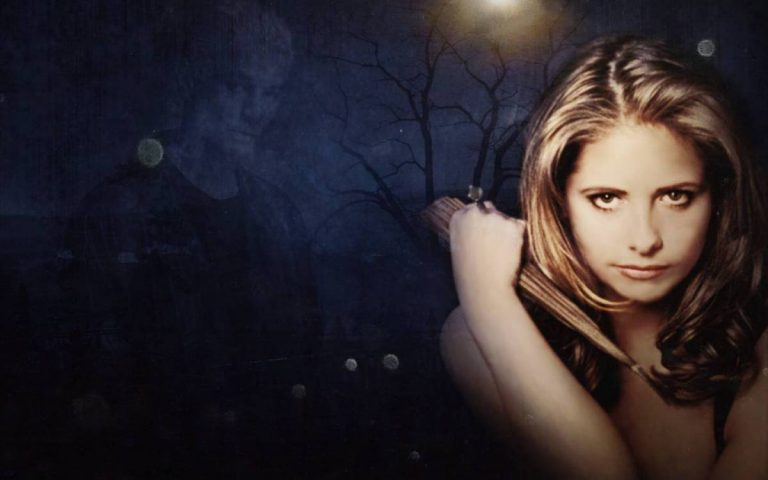This month marks twenty-one years since the ending of TV staple, Buffy The Vampire Slayer, as well as twenty years since the end of its shorter-lived spin-off, Angel. Though it’s been two decades since it ended, with little in the way of new content save for the occasional audiobook, and a supposed reboot having gone nowhere, the impact of the show on popular culture remains huge.
A phenomenon in its day, which made an icon out of its star and left an indelible mark upon a whole swathe of pop culture giants that have come since, Buffy’s been cited as an influence on the writing style of shows like Doctor Who, and sharing the same creators as the Marvel franchise. We take a look at some of its finest moments, with a breakdown of some of its best episodes, which helped to turn this cheesy vampire show into a sensation still being dissected by academics and YouTubers alike.
10. Once More With Feeling
Numerous shows have tried a musical episode, a gimmick which so often is just that, a gimmick that is done for the sake of it. H owever, this Buffy The Vampire Slayer episode from Season 6, which helped to kick start the trend, is still perhaps the best example of the form out there. The result of a curse that causes everyone to burst into song, the episode is a great example not only of how the show would experiment with format, but plays with the gimmick itself to deliver moments of comedy – the song about a parking ticket being a great bit – but also to further develop each of the main characters, as all of their secrets are exposed.
9. Normal Again

Season 6 is perhaps the most controversial in the show’s run, for how dark it became, as it dealt with increasingly adult issues. As Buffy spends much of the season dealing with depression, this episode goes a step further, as she is tricked into believing this world, of demons and magic, is in fact not real. This episode has a great performance from Sarah Michelle Gellar, as we see Buffy’s psyche completely unravelling, but it also works brilliantly on a meta level, as the psychiatrist in her visions comments on the world she’s been living in. The final scene, where it’s left genuinely ambiguous as to which world is the reality, is absolutely chilling.
8. The Zeppo
This episode from Season 3 focuses entirely on Xander, the non-superpowered member of the group, as he ends up embroiled in his own miniature sidequest involving a bunch of goons trying to blow up the school, running parallel to the apocalyptic threat facing the rest of the gang. Xander as a character often isn’t a fan favourite having more than his fair share of problematic moments, as well as being one of the self-insert characters creator Joss Whedon tended to have in his shows. As such however, he does also tend to get some of the best lines throughout the show, and more importantly, is perhaps one of the most flawed, but also most relatable characters in it, as he struggles throughout to overcome his own insecurities. Nicholas Brendon is great here, in a consistently strong yet comedic episode, as his panicked attempts to resolve the threat on his own contrast starkly with the melodrama of Buffy, Angel and co.
7. Fool For Love

Spike, the antagonist for much of Buffy’s second season, was an immediate fan favourite, as the punk vampire who would reluctantly work with the gang. This episode, which explores his back story, is one of the best examples of how the show excelled at character development and world building, as it takes a character who still seemed purely villainous, and is able to flesh him out, in ways that seem completely natural, and which allows for a stellar performance from James Marsters. The juxtaposition between past and present scenes, particularly those from his fight on the subway, are edited together brilliantly, making for something that feels a lot more immediate and impactful than a standard flashback might be.
6. Passions
The first season of Buffy The Vampire Slayer is perhaps the one that’s aged the poorest, with its campy tone, and low budget production values. It’s still a lot of fun, but it was clear that the show was still finding its feet. It’s in the second season where things really pick up a gear, especially after Buffy’s love interest Angel turns bad, and it’s in this episode where the show goes all in on this premise.
From the opening scenes, scored to Morcheeba, there’s an ominous feel, as Buffy is stalked unknowingly, and from there the tension only builds leading up till the brutal dispatch of semi-regular Jenny. The sadistic display viewers get here was the first real testament that this show had teeth.
5. Hush

Inspired by criticisms that Buffy The Vampire Slayer’s success was owed chiefly to its snappy dialogue, Joss Whedon penned this fan-favourite of an episode, which sees everyone in Sunnydale losing their voices. Playing for much of the runtime almost like a silent horror movie, the show is able to carry over all that it really excels at, from its horror, to even its snappy sense of humour, all without any actual dialogue.
The soundtrack throughout is haunting and suspenseful, while the episode’s adversaries, The Gentlemen, are perhaps the creepiest in the show’s entire run, with their gaunt faces and fixed grins. The scenes in which they disembowel one of their victims, all whilst they cannot scream, is perhaps as close to all-out horror as the show gets.
4. The Gift
The finale to Buffy’s fifth season, there would still be two seasons of the show to come after this one – yet this one feels like the perfect close to the show in many ways. From the first few minutes, where we get a recap of the entire show as a whole, and the standalone sequence in which we see Buffy face a vampire who doesn’t even know her, the whole of the episode feels like a perfect close to the arcs and character development that had been set up thus far.
After numerous episodes of build up, the stakes are clearly defined, leading to a final showdown that feels more climactic than any the show had yet done. The fight being against a literal God makes it feel as if it could genuinely go either way whilst at the same time feeling genuinely personal thanks to the role of Buffy’s sister, whilst her paying the ultimate sacrifice in the episodes closing moments makes for a fitting note to end on.
3. The Body

A truly unique episode, it’s one that feels like it could easily have been lifted from an entirely different show. Following the death of Buffy’s mother, almost the entire runtime of the episode takes a complete break from the usual formula of slaying vampires and other supernatural entities, and, for 45 minutes, focuses entirely on each of the main characters’ reactions to this loss.
With a raw, intense filming style, an almost non-existent soundtrack, and some incredibly powerful performances from the cast – and from Sarah Michelle Gellar in particular – this manages not only to be a bold piece of experimentation for this show, but simply one of the best, and most realistic depictions of death and loss out there.
2. Restless
Season 4 of Buffy The Vampire Slayer is a bit of a disjointed season – purposefully so at times, in a reflection of the switch from high school to university. As with prior seasons we have a couple of episodes, building to the finale, only then, suddenly everything appears to have been wrapped up early, with an episode of the season still to go. With the threat defeated, we cut to our main cast slumped in front of the TV, fast asleep. The show had done dream sequences before, but here it takes up the whole episode, as we see each of the main four characters facing an unknown entity within their subconscious.
It’s an episode which is up there with any David Lynch film in capturing perfectly the feel of a dream, with it’s surreal, nonsensical sequences and skewed camera angles, as well as how it brilliantly uses it’s artificial sets to allow for one moment to bleed into another. It makes for some brilliant comic moments, from the pastiche of Apocalypse Now, to the Cheese Guy, but also draws on the four seasons of development that had gone into each of these characters, highlighting each of their own insecurities and inner conflicts. It’s also one that greatly rewards rewatches, in how it hints at moments still to come.
1. Conversations With Dead People

Following a reduced cast, as they each face encounters with the dead alone, this episode from the final season of Buffy The Vampire Slayer is one that is at once one of the most experimental in the show’s run, whilst also encapsulating almost everything that made it work so well.
The scenes with the dead psychiatrist-turned-vampire, Holden, in which, mid-fight, he becomes Buffy’s literal therapist, with her sitting on a grave as if it were a psychiatrist’s couch, are comedy gold. Every line of dialogue sings, Holden is instantly likeable, but more than that – these moments still work on a much deeper level, helping to further develop Buffy’s character in the run up to the show’s ending.
At the same time, the scenes we get with Dawn and Willow, as something haunts their house. The horrific images of Buffy’s mother being tormented by an unknown entity, and haunting messages written in blood, are genuinely chilling. The scenes in which side characters Jonathan and Andrew reminisce on high school also work really well as a final goodbye to that chapter of life, as well as to the show which was defined by that world for so many of its earlier years.
READ NEXT: 10 N64 Games That Actually Need A Remake
Some of the coverage you find on Cultured Vultures contains affiliate links, which provide us with small commissions based on purchases made from visiting our site.

